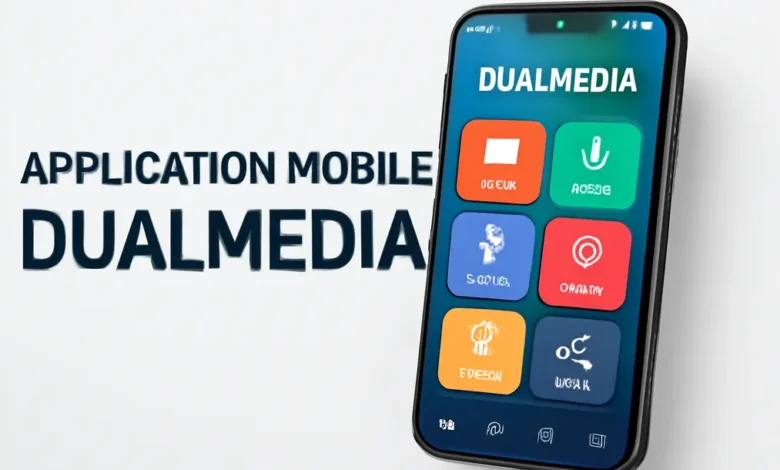Understanding Application Mobile DualMedia: A Game-Changer in the Tech World

In the ever-evolving world of mobile technology, innovations that enhance user experience and functionality are always in demand. One such breakthrough is the emergence of Application Mobile DualMedia. These applications are designed to bridge the gap between different media formats and provide users with an integrated experience. Whether it’s for entertainment, business, or personal use, Application Mobile DualMedia apps have proven to be incredibly versatile and beneficial. Let’s explore this fascinating topic and understand why dual media apps are becoming a significant player in the mobile app industry.
What is a Application Mobile DualMedia?
At its core, a Application Mobile DualMedia is one that allows users to seamlessly interact with two types of media, such as audio and video, simultaneously. Unlike traditional apps that focus on a single media type, Application Mobile DualMedia apps combine functionalities to enhance the user experience. These apps are especially popular in fields like entertainment, social networking, and educational platforms, where there’s a constant need to engage users with both visual and auditory content.
The integration of two media formats in a single application opens up numerous possibilities. For instance, a Application Mobile DualMedia could allow users to stream a video while listening to a podcast, or it could display images while streaming music. The goal is to create an engaging environment that encourages users to interact with multiple forms of content at once.
The Rising Popularity of Application Mobile DualMedia
In today’s fast-paced digital age, people demand more from their mobile applications. It’s no longer enough for an app to focus on just one type of media—users want a complete experience that caters to all their needs. Application Mobile DualMedia answer this call by offering multitasking capabilities, which make them incredibly popular across various industries.
Entertainment is one of the primary sectors benefiting from Application Mobile DualMedia. Take video streaming services, for example. Many platforms have introduced features where users can watch videos and interact with live chats, view comments, or even listen to background music without having to switch between apps. This integration allows users to enjoy immersive experiences without interruptions.
On the other hand, business and productivity apps are also utilizing Application Mobile DualMedia to enhance user workflows. Imagine a business meeting where participants can collaborate on a presentation while listening to a podcast or an audio explanation. This dual media functionality fosters creativity and encourages multitasking, making the apps even more valuable to professionals.
Key Features of Application Mobile DualMedia
Application Mobile DualMedia come with several features that distinguish them from conventional apps. Below are the key features that make these applications stand out:
1. Multi-format Media Integration
One of the standout features of dual media apps is their ability to integrate various forms of media. Whether it’s combining audio with video, mixing text with images, or using augmented reality (AR) alongside a live stream, these apps are designed to offer a richer media experience. For example, a fitness app may allow users to watch workout videos while simultaneously tracking their heart rate with audio prompts guiding them through each exercise.
2. Enhanced User Engagement
By incorporating multiple media types into one platform, dual media apps inherently boost user engagement. Users are no longer just passive consumers of content—they can interact, share, and respond to what they see and hear. This interactivity fosters a sense of involvement, making users more likely to stay engaged with the app for longer periods of time.
3. Increased Functionality and Flexibility
Dual media apps provide users with greater flexibility, allowing them to perform more tasks at once. Imagine being able to edit a video while simultaneously recording a voiceover. This multitasking capability improves user experience and productivity, particularly in business, creative, and educational settings.
Real-World Application Mobile DualMedia
The use cases for dual media mobile apps are endless. From social media platforms to e-learning tools, Application Mobile DualMedia are transforming various industries. Let’s take a closer look at some popular real-world applications.
1. Social Media Platforms
Many social media apps are introducing dual media capabilities to enhance user experience. Instagram, for instance, allows users to share both photos and short video clips in their stories. Similarly, TikTok lets users add music or sound effects to their videos, creating a multimedia experience in real-time.
Additionally, live-streaming platforms like Twitch use dual media to combine video streaming with real-time chatting and audience interaction, creating a dynamic experience for both content creators and viewers.
2. Educational Apps
Application Mobile DualMedia have proven to be a game-changer in education. Apps like Khan Academy and Duolingo combine text, audio, and video to create immersive learning experiences. Learners can watch instructional videos, listen to explanations, and follow along with text-based material, all within the same app.
Furthermore, virtual classrooms use dual media for better student engagement. Students can view lecture videos while listening to live discussions, all while interacting with peers and instructors in real-time.
3. Entertainment and Streaming Apps
Entertainment apps such as Netflix and Spotify have taken advantage of dual media by enabling users to watch shows while listening to a soundtrack or playlist simultaneously. YouTube also offers a similar experience where users can watch videos while browsing through comments or live chats.
Moreover, gaming apps are incorporating dual media features to create more interactive and visually immersive environments. Players can now experience high-quality graphics and sound while interacting with other players through voice chat, bringing a whole new level of interactivity to the gaming world.
The Challenges of Developing Application Mobile DualMedia
While dual media apps offer many advantages, developing them comes with its set of challenges. For app developers, ensuring that both media types function seamlessly is a complex task. Here are some challenges developers face when building Application Mobile DualMedia:
1. Optimizing Performance
Combining two media types—especially video and audio—requires significant processing power. Ensuring that the app runs smoothly without lag or buffering is a challenge. Developers need to optimize the app’s performance to ensure that it delivers high-quality media without draining the device’s battery.
2. User Interface Design
Designing an intuitive user interface (UI) for dual media apps is critical. The UI must be simple, user-friendly, and accommodating for different types of media. Balancing video content, audio controls, text, and other media elements can be tricky, as the design needs to be responsive and adaptable to various devices and screen sizes.
3. Data Consumption and Storage
Application Mobile DualMedia, particularly those that deal with video or high-quality audio, can consume a lot of data and storage. Users on limited data plans may struggle with excessive data consumption, while devices with low storage may encounter issues with app performance. Ensuring that dual media apps are optimized for both storage and data usage is an ongoing challenge for developers.
The Future of Dual Media Mobile Applications
The future of Application Mobile DualMedia looks bright, with continuous advancements in technology paving the way for even more innovative features. With the rise of 5G technology, the ability to stream high-quality video and audio in real-time will become more seamless. This will enhance the capabilities of dual media apps, making them even more engaging and immersive.
Augmented reality (AR) and virtual reality (VR) are also playing a significant role in shaping the future of dual media apps. By incorporating AR/VR into dual media experiences, apps can offer interactive environments where users can view 3D objects while listening to spatial audio, creating an even more immersive experience.
Moreover, the development of AI-driven apps will enable personalized content delivery, allowing users to consume media that’s tailored to their interests. As AI continues to evolve, dual media apps will become smarter and more intuitive, offering users a truly customized experience.
Conclusion
Application Mobile DualMedia are revolutionizing the way we interact with media. By combining audio, video, and other content types into a single app, these apps are enhancing user engagement, improving productivity, and offering a more immersive experience. As technology continues to evolve, the capabilities of dual media apps will only grow, offering new possibilities for entertainment, education, business, and beyond. With the right balance of performance, design, and functionality, dual media apps are undoubtedly the future of mobile technology.



